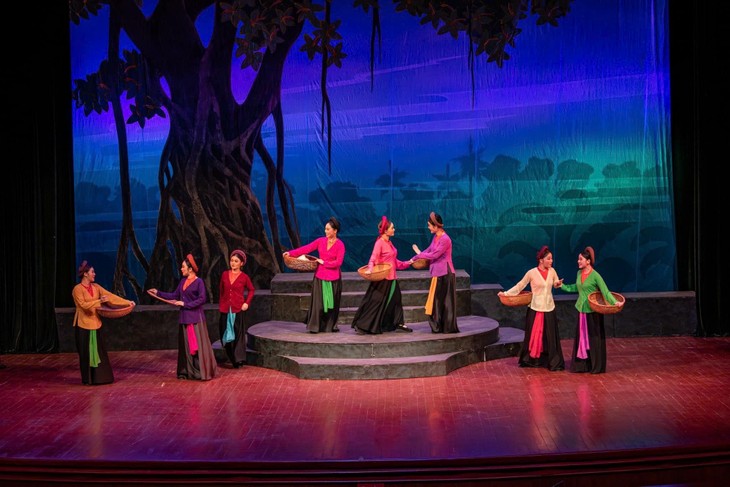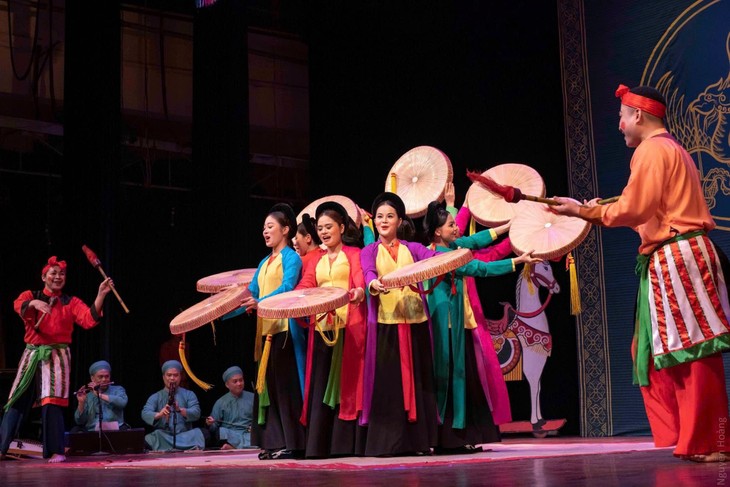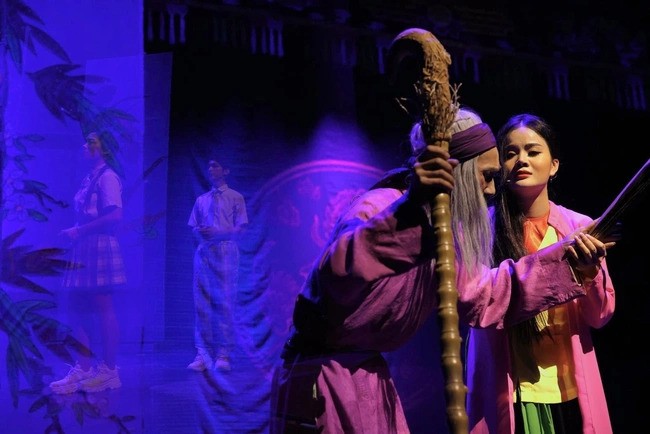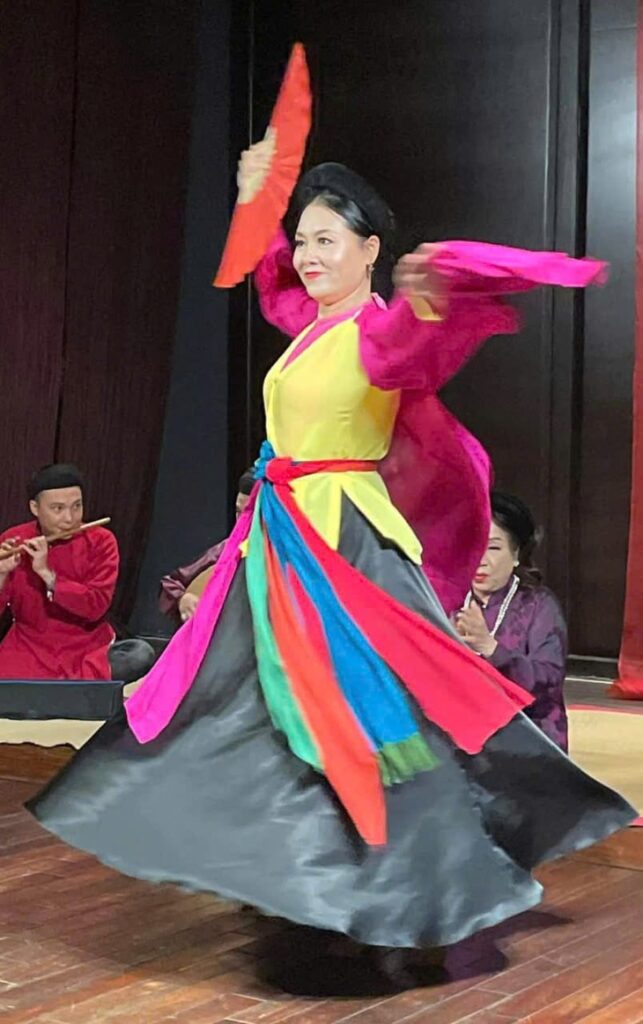Rooted in the Red River Delta, Cheo – a traditional theatrical art genre – has flourished for centuries, blending music, storytelling, and cultural identity into a captivating art form. Cheo expresses a rich spectrum of emotions - from lyrical romance to playful satire. But how can we keep this heritage alive in modern times? Digitization, education, and creative fusion with contemporary music are making Cheo more accessible while preserving its essence.
Today, we’ll explore the timeless beauty of Cheo melodies and the innovative ways it continues to thrive. To guide us on this journey is People's Artist Le Tuan Cuong, Deputy Director of the Vietnam National Cheo Theater, and People's Artist Thuy Ngan, who has 45 years of experience and is a professor at the Hanoi University of Theatre and Cinema.
“Dao Lieu”, a traditional Vietnamese Cheo melody is renowned for its lyrical beauty and emotive depth. This piece captures the emotions of a young woman in love, expressing feelings of longing and optimism.
According to several sources, Cheo first appeared in the 10th century in Ninh Binh province before spreading throughout the Red River Delta, Thai Binh, Hai Phong, Ha Nam, Hung Yen, and Ha Noi. This theater genre embodies the soul of rural Vietnam, expressed through its melodies.
Cheo melodies evolved from the folk music of Northern Vietnam following a form of hat noi (a style of rhythmic recitation), incorporating parallel prose and various poetic structures into Cheo singing.

The classic Cheo play entitled Quan Am Thi Kinh (Goddess of Mercy) on the stage (Photo courtesy of People’s Artist Thuy Ngan)
People’s Artist Thuy Ngan said: "Cheo has more than 200 melodies, 150 of which have been documented. These melodies bring different characters to life: scholars, young women, comedians… Each melody is a different color in our artistic palette."
The 200-plus Cheo melodies, derived from folk songs, proverbs, and poetry, are rich in literary and lyrical qualities.
Each Cheo melody serves an expressive function, conveying the emotions and states of characters in specific situations. Some of the most notable melodies in Cheo include Dao lieu, Loi lo, Do dua, and Lan tham, which embody essential elements of vocal music: lyricism, drama, and tonal richness. People’s Artist Thuy Ngan said:
“Let’s take Dao Lieu melody as an example. Dao Lieu originally came from the elders. In the past, there was no official composer - it was more like a collective effort, where each person contributed a verse. It was similar to the way folk poems were structured, with each person composing one line. When sung, the lyrics incorporated folk literature and proverbs. Over time, the song became closely associated with two characters: Tran Phuong and Suy Van. The lyrics suggest themes of marriage and love, emphasizing the idea that if one does not love, they may miss their chance - like the saying “spring does not come twice”.

The classic Cheo play entitled Quan Am Thi Kinh (Goddess of Mercy) on the stage (Photo courtesy of People’s Artist Thuy Ngan)
Each melody has its own unique character. Ngan says it requires certain techniques to perform different kinds of Cheo melodies.
“For example, take the “Loi Lo” melody. This melody is lively, fast-paced, and playful. But if someone sings it in a slow and smooth way, that completely changes the song’s typical character, which would be entirely incorrect. The “Loi Lo” melody is relatively new. It came later and is not from the 11th, 12th, or even 17th century. It emerged during the contemporary Cheo period, referring to the modernization of Cheo, transitioning it from rural villages to urban settings.”
“The rhythm and beat of Cheo melodies vary. The melody the Long Journey follows the 6/8 rhythm, conveying a fast-paced, lively feeling while the famous Champion section from the play :uu Binh Duong Le based on the tale of two friends Luu Binh and Duong Le, where there is a farewell scene, we use the 4/4 rhythm. This rhythm carries a sense of sorrow and melancholy, making it ideal for farewell scenes between characters. The lyrics are a dialogue between the characters. The performers must have a strong grasp of musicality while maintaining a natural and expressive delivery,” Ngan said.

The exceprt of the Cheo play "Quan am Thi Kinh"
Over the centuries, Cheo melodies have demonstrated their enduring vitality, appearing in various events and artistic forms. Le Tuan Cuong, Deputy Director of the Vietnam National Cheo Theater, says Cheo has evolved over the centuries.
“To claim that traditional Cheo remains static and does not renew itself is inaccurate. Cheo is like a river that continuously reinvents itself while retaining its original strength. Its survival attests to its ability to resonate with each new generation.”
But how can this traditional art be preserved and yet accessible to younger generations? Artists, researchers, and theater directors are joining forces to breathe new life into it.
You just heard Dao Lieu, but in a different version from the one presented at the beginning of our program, performed by People’s Artist Thuy Ngan. Its recent transformation in the TV show Call me by fire beautifully illustrates this artistic revival. The bold fusion of rap with ancestral melodies creates a unique symphony where tradition and modernity dance in harmony. This electrifying blend, while preserving the essence of Cheo, revives the festive spirit of northern Vietnamese villages, where the red glow of lanterns still lingers in memories. Dao Lieu quickly became one of the most searched titles on social media after the show.
To bring Cheo to younger audiences, the Vietnam Cheo Theater has launched innovative initiatives, such as an educational heritage program for high school students in Hanoi. In this program, Thi Mau, a character from the famous Cheo play Quan Am Thi Kinh, adopts contemporary accents.
Le Tuan Cuong explains: “For the play Thi Mau Across Time, which usually lasts two and a half hours, I only had an hour and a half. So, I integrated elements of rap and rock while combining narration with traditional Cheo theater. However, when presenting the characters of Thi Kinh and Thi Mau, I ensured that the foundations of tradition were fully respected. It was the rhythm, modernity, and realism that were adapted to engage a contemporary audience. The young spectators do not remain passive; they become active participants in this discovery, interacting with artists and musicians and truly experiencing the essence of Cheo."
To make Chèo melodies more accessible to the public, the lyrics of traditional tunes have been adapted to better meet audience expectations. Artist Thuy Ngan shares an example: “Take the melody Ke hanh du ke, a traditional tune I used to portray Thi Kinh. This same melody has been adapted to tell the story of Au Co, the mythical mother of the Vietnamese people. The melody remains traditional, but the lyrics have evolved to tell new stories."”
In the digital era, Cheo theater is finding a new lease on life on social media, creating unprecedented connections with contemporary audiences. While this modernization is promising, it raises questions about the authenticity of this ancient art. Adaptation is necessary, but it carries the risk of distorting the essence of Cheo. A delicate balance must be struck, calling for rigorous criteria to guide innovations without betraying the ancestral heritage.
Le Tuan Cuong said: “Social media is a double-edged sword. It allows Cheo to reach a wider audience, but we must ensure that adaptations respect its traditional essence. We are working to establish criteria that will guarantee that innovations do not distort this art form.”
The preservation of Cheo relies on the recognition and promotion of exceptional artists like Thanh Ngoan and Thuy Ngan, who safeguard and pass on this tradition.
“We have already reconstructed 100 traditional melodies with artist Thanh Ngoan. We must do the same with Thuy Ngan. Her exceptional talent - her voice, technique, and stage presence - makes her a valuable artist for transmitting this art to future generations,” Cuong said.
Today, an encouraging phenomenon is emerging. Cheo is now flourishing beyond its traditional borders. From village communal houses to schools, it is making its way with renewed vigor. Hai Duong and Thai Binh provinces are incorporating Cheo into their school programs, while Hanoi’s cultural centers resonate with its ancient melodies. Artist Thuy Ngan says she is impressed with the growing enthusiasm of the folk art among the contemporary public.

People's Artist Thuy Ngan perform in a Cheo play called “Suy Van” (Photo courtesy of People’s Artist Thuy Ngan)
Thuy Ngan said: “As a Cheo artist, I’m delighted to have been invited to teach Cheo singing at Ha Noi's cultural centers to promote this art. The participants are numerous, singing with enthusiasm and talent. Cheo clubs are multiplying, and many performances have been organized, creating a favorable environment for the flourishing of Cheo."
Vietnam is currently preparing a dossier to submit to UNESCO to have Cheo recognized as part of the Intangible Cultural Heritage of Humanity.
Kim Chi
















